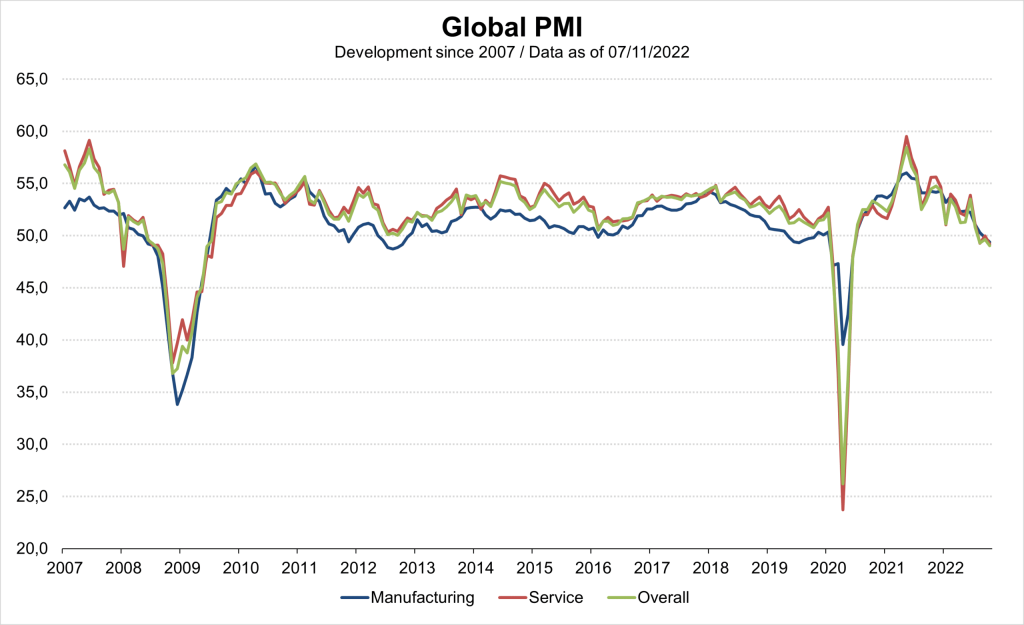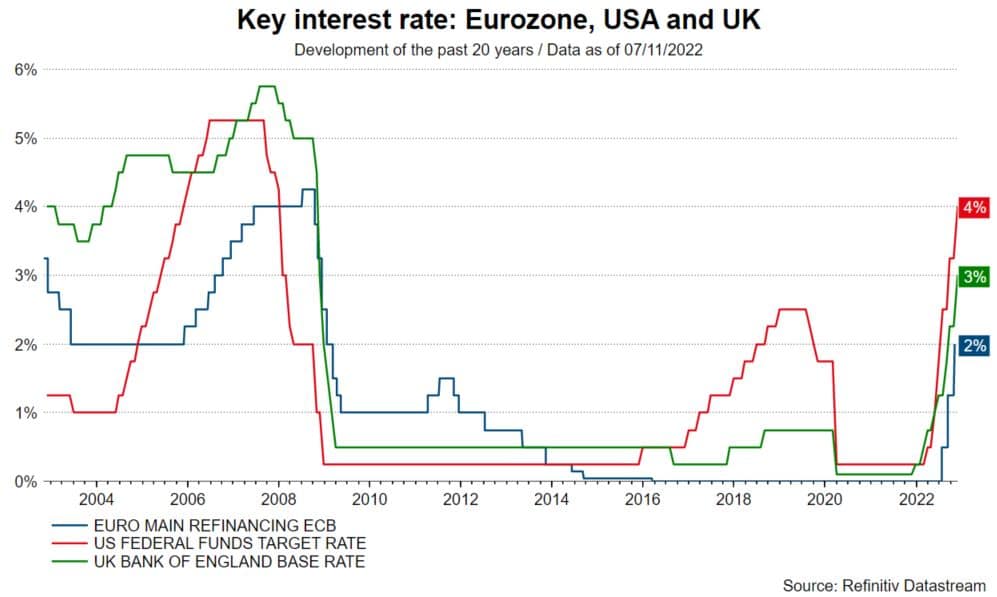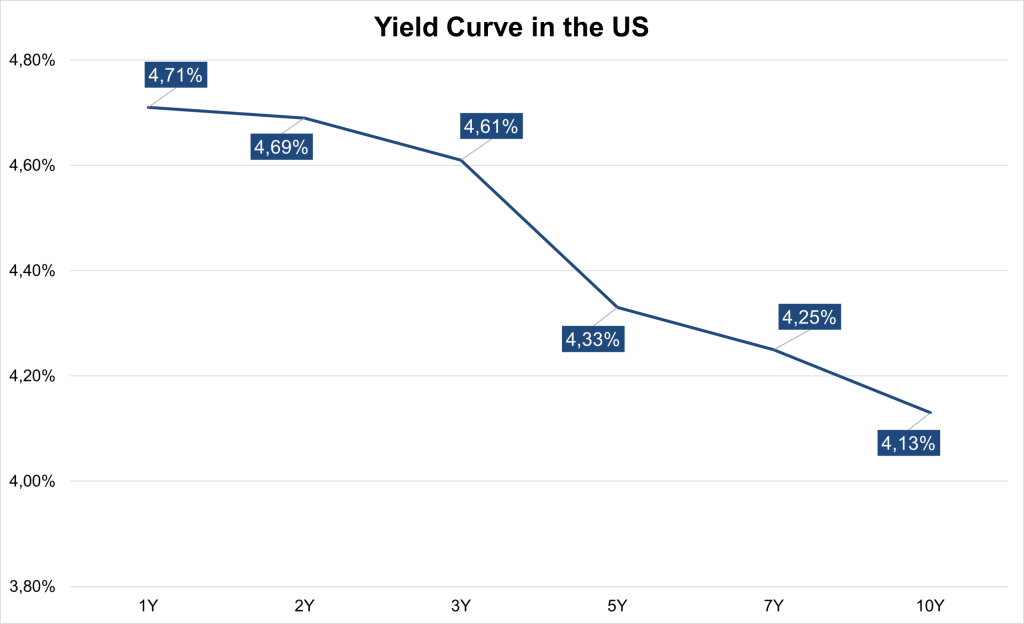Falling economic indicators
The majority of economic indicators are in line with weak real economic growth. However, the falling trend is worrying. For example, the global purchasing managers’ index also continued its falling trend in the month of October (49.0). The low level of new orders (49.1) points to weakening demand. The employment component (at 51.0) has also lost some of its strength in recent months. Unsurprisingly, the sentiment component has fallen further. After all, sales prices are also down. It is also noteworthy that both sectors (manufacturing: 49.4; services: 49.2) are losing momentum in numerous countries. Because the rapid, strong and synchronous increases in key interest rates and the higher cost of capital are only reaching the real economy with a time lag, a further weakening of economic activity is likely. The risks of a global recession have increased.

Note: Past performance is not a reliable indicator for future performance of an investment.
Reduction in the pace of interest rate hikes
More and more central banks are signaling a reduction in the pace at which they raise policy rates. However, this does not necessarily mean that central banks are softening their focus on fighting inflation. Even a pause in the raising cycle may represent hawkish policy when (falling) economic growth indicators would actually already call for rate cuts.
Fed remains hawkish
The US Federal Reserve provides a good example of this. Last week, the key interest rate (upper band) was raised from 3.25% to 4.0% in the USA, as generally expected. The statement on the interest rate decision talks about the fact that future decisions will also take into account the interest rate hikes that have been made so far and the time-lagged effect of monetary policy on the real economy. This provides a hint for a December rate hike from 4.0% to 4.5%. However, in the press conference, Chairman Powell opined that data suggest a higher end point for rate hikes than originally thought (in September). This points to a key interest rate level of at least 5% in the first quarter.

Note: Past performance is not a reliable indicator for future performance of an investment.
For a pause a change in inflation dynamics is necessary
A necessary condition for a pause in the rate hike cycle is a change in inflation dynamics. Until September, inflation data surprised to the upside in many countries. When this process breaks, it becomes easier for a central bank to argue a pause without losing credibility. After all, the case for falling inflationary pressures is growing: commodity prices for energy have fallen, goods price inflation is falling, delivery times are getting shorter, and evidence of falling price pressures due to falling demand is also growing. Both the magnitude of first-round effects (from energy to the other sectors) and that of second-round effects (wage developments) remain a major uncertainty. Since the beginning of 2021, inflation dynamics are not sufficiently understood.
ECB signals further interest rate hikes
This can also explain the rather hawkish statements made by numerous members of the ECB Governing Council. After all, the flash estimate for consumer price inflation in October was (once again) above expectations at 1.5% on a monthly basis and 10.7% on an annual basis. A further interest rate hike in December by at least 0.5 percentage points to 2% (discount rate) is likely. All the more so as the unemployment rate in the euro zone reached a new low of 6.6% in September.
Inverted yield curve in the USA
In the USA, the two-year yield on government bonds has now been above the ten-year yield since July (currently: 0.5 percentage points). Statistically, this provides a strong indication of an impending recession. This environment of an inverted yield curve is likely to persist. This is because the Fed is signaling that it will keep key interest rates at a restrictive level for some time, even if this means pain.

Bank of England becomes dovish
What happens when you change the rhetoric too soon from hawkish (geared toward fighting inflation) to dovish (geared toward weak growth) can be seen in the policy of the central bank in the United Kingdom (Bank of England). Last week, the key interest rate was raised further and sharply by 0.75 percentage points to 3.0%. However, the statement said that the key interest rates priced into the market (then at over 5%) were too high because they would trigger a severe recession. With inflation rates in September at 0.5% on a monthly basis and 10.1% on an annual basis, the signal effect was unfavorable. Interest rate hike expectations (the two-year yield) fell, while the ten-year yield rose (higher inflation risks).
In the current environment, where inflation rates are high and the inflation dynamic is not well understood, the biggest risk for monetary policy is that it is not hawkish enough (too few rate hikes, rate cuts too early). This is because if inflation persistence remains high, it could be difficult to reduce it. At least the U.S. Federal Reserve is following this policy. A reduction in the pace does not mean a departure a hawkish policy stance. However, a reduction of the interest rate hike expectation priced into the market by mild statements (with regard to the fight against inflation) does.
In the current environment, where inflation rates are high and momentum is not well understood, the biggest risk for monetary policy is that it is not sharp enough (too few rate hikes, rate cuts too early). This is because if inflation persistence remains high, it could be difficult to contain. At least the U.S. Federal Reserve is following this policy. A reduction in the pace does not mean a departure from a hawkish monetary policy stance. However, a reduction of the interest rate hike expectation priced into the market caused by dovish statements (with regard to the fight against inflation) does.
For a glossary of technical terms, please visit this link: Fund Glossary | Erste Asset Management
Legal note:
Prognoses are no reliable indicator for future performance.
Legal disclaimer
This document is an advertisement. Unless indicated otherwise, source: Erste Asset Management GmbH. The language of communication of the sales offices is German and the languages of communication of the Management Company also include English.
The prospectus for UCITS funds (including any amendments) is prepared and published in accordance with the provisions of the InvFG 2011 as amended. Information for Investors pursuant to § 21 AIFMG is prepared for the alternative investment funds (AIF) administered by Erste Asset Management GmbH pursuant to the provisions of the AIFMG in conjunction with the InvFG 2011.
The currently valid versions of the prospectus, the Information for Investors pursuant to § 21 AIFMG, and the key information document can be found on the website www.erste-am.com under “Mandatory publications” and can be obtained free of charge by interested investors at the offices of the Management Company and at the offices of the depositary bank. The exact date of the most recent publication of the prospectus, the languages in which the fund prospectus or the Information for Investors pursuant to Art 21 AIFMG and the key information document are available, and any other locations where the documents can be obtained are indicated on the website www.erste-am.com. A summary of the investor rights is available in German and English on the website www.erste-am.com/investor-rights and can also be obtained from the Management Company.
The Management Company can decide to suspend the provisions it has taken for the sale of unit certificates in other countries in accordance with the regulatory requirements.
Note: You are about to purchase a product that may be difficult to understand. We recommend that you read the indicated fund documents before making an investment decision. In addition to the locations listed above, you can obtain these documents free of charge at the offices of the referring Sparkassen bank and the offices of Erste Bank der oesterreichischen Sparkassen AG. You can also access these documents electronically at www.erste-am.com.
Our analyses and conclusions are general in nature and do not take into account the individual characteristics of our investors in terms of earnings, taxation, experience and knowledge, investment objective, financial position, capacity for loss, and risk tolerance. Past performance is not a reliable indicator of the future performance of a fund.
Please note: Investments in securities entail risks in addition to the opportunities presented here. The value of units and their earnings can rise and fall. Changes in exchange rates can also have a positive or negative effect on the value of an investment. For this reason, you may receive less than your originally invested amount when you redeem your units. Persons who are interested in purchasing units in investment funds are advised to read the current fund prospectus(es) and the Information for Investors pursuant to § 21 AIFMG, especially the risk notices they contain, before making an investment decision. If the fund currency is different than the investor’s home currency, changes in the relevant exchange rate can positively or negatively influence the value of the investment and the amount of the costs associated with the fund in the home currency.
We are not permitted to directly or indirectly offer, sell, transfer, or deliver this financial product to natural or legal persons whose place of residence or domicile is located in a country where this is legally prohibited. In this case, we may not provide any product information, either.
Please consult the corresponding information in the fund prospectus and the Information for Investors pursuant to § 21 AIFMG for restrictions on the sale of the fund to American or Russian citizens.
It is expressly noted that this communication does not provide any investment recommendations, but only expresses our current market assessment. Thus, this communication is not a substitute for investment advice.
This document does not represent a sales activity of the Management Company and therefore may not be construed as an offer for the purchase or sale of financial or investment instruments.
Erste Asset Management GmbH is affiliated with the Erste Bank and austrian Sparkassen banks.
Please also read the “Information about us and our securities services” published by your bank.


